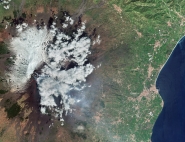Mission

mission Goals
Ocean services that Sentinel-3 is expected to provide include numerical ocean modelling, maritime safety and monitoring of coasts, the deep oceans and ice. Sentinel-3 will also be training its sights on land surfaces and the cryosphere. In each of these domains, the key variables to be closely watched are sea surface height (SSH), sea surface temperature (SST), ocean colour (OC), land colour (LC), river and lake levels and sea ice thickness.
The Copernicus Marine Environment Monitoring Service (CMEMS) will distribute Sentinel-3 data for operational oceanography centres.
orbit
The Sentinel-3 satellites are in a similar—but not identical—orbit to that of the ERS, Envisat and SARAL satellites. This orbit is highly inclined (polar or near-polar), Sun-synchronous and able to revisit any point on the globe every 1 to 3 days, in line with the mission’s science requirements and the optical instruments. In a Sun-synchronous orbit, the surface below the satellite is always viewed at the same solar illumination angle.
Coverage of Sentinel-3’s orbit
Choice of orbit
The choice of a Sun-synchronous orbit is vital for the ocean colour and surface temperature sensors, and this is what dictated the satellite’s configuration. A similar choice was made for the ERS-1 mission, for which the orbit was designed to serve a range of disciplines with a repeat cycle of 35 days. The altitude of 800 km and the inclination were also key parameters. ERS-2, Envisat and SARAL were lofted into the same orbit as ERS-1. Sentinel-3 is in a nearby but slightly different orbit—repeat cycle 27 days, altitude 814.5 km and inclination 98.65°—for the same reasons.
Manoeuvres
A satellite’s orbital parameters tend to drift over time, notably as a result of drag. Over the long term, more or less periodic variations also occur as a result of Earth’s non-uniform gravity field, solar radiation pressure and other forces of lesser amplitude.
How often a satellite’s orbit has to be corrected depends largely on solar activity. Manoeuvres are usually performed every 40 to 200 days, each lasting 20 to 60 minutes. These manoeuvres are mainly commanded from the ground to minimize the impact on data.
Orbit parameters
Main parameters
- semi-major axis: 7177.926540 km
- eccentricity: 0.001148
- perigee argument: 90.0°
- inclination (Sun-synchronous): 98.65°
Auxiliary parameters
- mean altitude: 814.5 km
- nodal period: 100.987 min
- repeat cycle: 27 days
- number of revolutions per cycle: 385
- number of half-revolutions per cycle: 770
- ground track spacing at equator: 104 km



